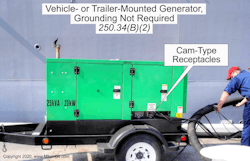Courtesy of www.MikeHolt.com
Q. What does the Code define as a dormitory unit?
A. Dormitory Unit. A building, or a space in a building, in which group sleeping accommodations are provided for more than 16 persons who are not members of the same family in one room, or a series of closely associated rooms, under joint occupancy and single management, with or without meals, but without individual cooking facilities [Art. 100 Definitions].
Q. What NEC conditions allow for the installation of high-impedance grounded systems?
A. To limit ground-fault current to a low value, a high-impedance grounded system is permitted to be installed on 3-phase systems of 480V up to 1,000V where all the following conditions are met [Sec. 250.36]:
(1) Conditions of maintenance and supervision ensure that only qualified persons service the installation.
(2) Ground detectors are installed on the system.
(3) Only line-to-line loads are served.
Informational Note: According to Annex O of NFPA 70E, Standard for Electrical Safety in the Workplace, high-impedance grounding is an effective tool to reduce arc flash hazards.
Author’s Comments:
- High-resistance grounding will insert an impedance in the ground return path and will typically limit the fault current to 10A or less, leaving insufficient fault energy and thereby reducing the arc-flash hazard level. High-resistance grounding will not affect arc-flash energy for line-to-line faults [Annex O NFPA 70E].
- High-impedance grounded systems are generally referred to as “High-Resistance Grounded Systems” in the industry. These systems are generally used where sudden interruption of power will create increased hazards and where a reduction of incident energy is needed for worker safety.
(A) Grounding Impedance Location. A grounding impedance is typically a resistor installed between the neutral point of the separately derived system and the grounding electrode conductor (Fig. 1 below).
Q. What is the Code rule for the connection of a portable generator to a grounding electrode?
A. Section 250.34 Generators — Portable and Vehicle- or Trailer-Mounted
(A) Portable Generators. A portable generator is not required to be connected to a grounding electrode (grounded) if both [Sec. 250.34(A)]:
(1) The generator only supplies equipment and/or receptacles mounted on the generator.
(2) The normally noncurrent-carrying metal parts of equipment and the equipment grounding conductor terminals of the receptacles are connected to the generator frame.
Q. What is the Code rule for the connection of a vehicle- or trailer-mounted generator to a grounding electrode?
A. Section 250.34(B) Vehicle- and Trailer-Mounted Generators. Vehicle- and trailer-mounted generators are not required to be connected to a grounding electrode (grounded) if:
(1) The generator frame is bonded to the vehicle or trailer frame.
(2) The generator only supplies equipment or receptacles mounted on the vehicle, trailer, or generator (Fig. 2 below).
(3) The normally noncurrent-carrying metal parts of equipment and the equipment grounding conductor terminals of the receptacles are connected to the generator frame.
These materials are provided to us by Mike Holt Enterprises in Leesburg, Fla. To view Code training materials offered by this company, visit www.mikeholt.com/code.







